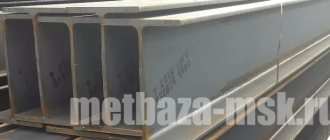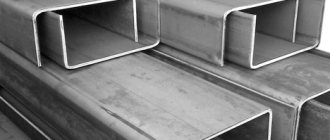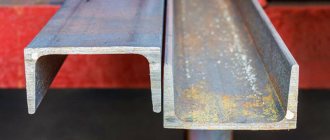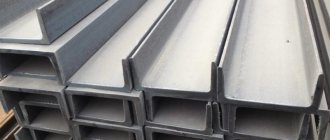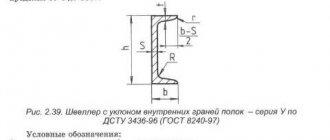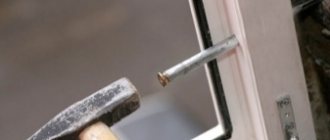Channel and I-beam are types of metal products with high strength characteristics. They are popular in construction, in the manufacture of medium and heavy equipment, and in the production of production lines. With the same height of the I-beam and the channel walls and comparable dimensions of the flanges, the I-beam has high strength and rigidity. However, much depends on the conditions of use of rolled metal, the direction of applied loads and methods of fastening.
Metal products with U- and H-shaped profiles are used precisely in those areas in which their technical characteristics are most fully used.
Main characteristics of the channel
Rolled metal of this type is produced by hot rolling and bending of strip blanks. According to the tables of GOST 8240, the wall height of a steel channel is 50-400 mm. Hot-rolled steel with inclined inner flange edges has an increased cross-sectional area and strength characteristics are similar to analogues with profile I. In order to increase strength and resistance to low temperatures, the rolled steel is made of high-quality steel.
The channel is convenient for installation on flat surfaces. Rolled steel is used to strengthen concrete structures, create frame structures, and in the production of light equipment and mechanisms. In private construction, the best choice is a channel rather than an I-beam, which is explained by the combination of sufficient strength and affordable cost of the U-shaped profile. The I-beam, due to its massiveness and high strength, is mainly used in large industrial and civil construction.
Main characteristics of an I-beam
I-beams are manufactured with inclined flange edges in accordance with GOST 8239-89 , the range of products with parallel edges corresponds to the tables of GOST 26020 or STO ASChM 20-93. The products are characterized by high rigidity and strength, the value of which, in addition to the cross-sectional dimensions, is influenced by:
- grade of steel from which metal products are made; for operation under high loads and in difficult temperature conditions, low-alloy steels of type 09GS are used;
- span length - the larger this value, the lower the load-bearing capacity of the I-beam;
- method of securing the beam, direction and nature of the load.
Comparison of I-beam and channel
The main difference between the properties of an I-beam and a channel is the different response to loads, in particular torsion, which is explained by the difference in the location of the center of gravity.
- I-beam . The maximum volume of metal, especially in products of the wide-flange and column series, is concentrated in the shelves. The I-beam flanges, symmetrical relative to the wall, absorb the main vertical loads and provide a high moment of inertia. The wall works mainly in compression. This symmetrical profile can only be subject to torsion in cases where a floor with an uneven load is laid on it. The I-beam, due to its massiveness, high cost and strength characteristics, is used mainly in large-scale construction to create floors that experience high loads.
- Channel . Its main feature is the mismatch of the main axis of inertia with the wall. Such products work well with oblique bending. To create a light and durable metal structure, the channel is welded into a box with the seam reinforced with metal plates. Creating such metal products requires a lot of labor. The channel is most often used to create frame structures, make floors for small buildings - cottages, garages, outbuildings - as well as stairs.
Both the channel and the I-beam belong to profile rolled products, which are not designed to withstand serious forces directed perpendicular to the wall.
Strength
The I-beam profile evenly distributes the load on the shelves, and the wall rigidity is ensured on both sides. One beam can replace two channels if the load goes:
a) on the cross section of the beam (X axis),
b) at the end (if the beam is used as a support column).
If the load is applied from the side (Y axis in the figure), the channel wins.
For design structures, not only the width of the shelves is taken into account, but also derived characteristics: the thickness of the walls and shelves, the radius of curvature between the walls and the shelf.
To select a suitable profile, you should look in the tables to GOST to see the moments of resistance relative to the X and Y axes (Wx and Wy). It is this parameter that characterizes the resistance to torsion and bending in the specified plane. The higher it is, the stronger the product.
Sometimes welding of two channels wall to wall is used. The resulting homemade I-beam will be 10% less durable than a factory-made one. The method of welding channels in the form of a rectangle, with the ends of the shelves, is also used. However, in this case, a profile pipe would be preferable.
There are also channels with oblique flanges, the characteristics of which are close to those of I-beams.
Approximate comparison of I-beams and channels of similar sizes.
How are they visually different?
First, it’s worth understanding what each rental is. Channel - a product with 2 shelves fixed to the wall, has the shape of the letter P. A similar profile is divided into:
- U-shaped channels
- U-shaped channels
Regardless of the type, the production of channels is regulated by GOST 8240, which also indicates the regulatory characteristics of existing brands and subtypes of channel blanks.
An I-beam is a metal product consisting of two vertical shelves, the centers of which are connected by a wall . It is characterized by increased deflection strength and reliability, is available in lengths from 4 to 12 meters and has a solid section in the shape of the letter H.
The production of such elements is regulated by two regulatory documents: GOST 8239 and GOST 26020.
How to save when buying rolled metal
For the same task, you can use different rolled metal profiles. The correct selection of assortment will allow you to save not only money, but also effort. Also, for many structures (which do not have high requirements), it is enough to choose a range of normal strength and rigidity.
Another way to reduce costs is to buy a custom length profile, which sells at a lower price than a cut-to-length profile. But keep in mind that if the product is involved in a standard construction, then the profile will most likely have to be cut, and this is already a dubious saving.
In some cases, the best way to save money is not to skimp and purchase good rolled steel with an anti-corrosion coating so that the finished product will serve for a long time and will not require repairs or replacement of parts.
Differences in Application
I-beams are rolled products in demand in construction, which are used as load-bearing beams in the construction of large objects:
- bridges;
- high-rise structures;
- industrial buildings.
The channel is best used in low-rise construction. It is also often used in the construction of outbuildings. It is worth noting that, regardless of their purpose, both elements are used both as floors and as roofing elements.
Comparison of other characteristics
The difference between the two profiles also lies in the production features. I-beams are produced by welding the flanges and the wall. Production includes several stages, the main ones:
- preparation of blanks;
- assembly of the profile structure;
- welding elements to each other.
Very rarely, I-beams are produced using the hot-rolled method, which cannot be said about channels . In addition to this technique, GOST allows the production of channel profiles by bending blanks. Hot-rolled production of channels involves heating the material to a high temperature through the use of special equipment, followed by giving the workpiece the required shape. Bent elements are made in a cold way, bending the edges of the sheets at the desired angle.
If we compare both materials by price, the channel will be more expensive because it is heavier. I-beams have a low weight per linear meter, so the profile is popular in many areas.
What is stronger in bending - an I-beam or a channel?
With the same characteristics (material, length, cut thickness), a beam with an I-section can withstand bending better than a channel. The bending strength also depends on whether the beam will be rigidly fixed or supported, as well as on the length of the purlin.
I-beam: size table, weight and dimensional characteristics of profiles
Modern production allows us to produce profiles of various sizes, from a large number of materials and in a variety of configurations. It is possible to produce I-beams according to individual parameters.
This article contains a description of the most common I-beams in construction. For clarity of the information presented and the possibility of visual comparison, a table of sizes of I-beams is offered:
| Profile view | Width mm | Height mm | Shelf thickness, mm | Wall thickness, mm | Number of meters in 1 ton | Weight of 1 m length, kg |
| 10 | 55 | 100 | 7,2 | 4,5 | 105,7 | 9,456 |
| 12 | 64 | 120 | 7,3 | 4,8 | 86,62 | 11,54 |
| 14 | 73 | 140 | 7,5 | 4,9 | 73,09 | 13,68 |
| 16 | 81 | 160 | 7,8 | 5 | 62,94 | 15,89 |
| 18 | 90 | 180 | 8,1 | 5,1 | 54,50 | 18,35 |
| 18a | 100 | 180 | 8,3 | 5,1 | 50,20 | 19,92 |
| 20 | 100 | 200 | 8,4 | 5,2 | 47,53 | 21,04 |
| 20a | 110 | 200 | 8,6 | 5,2 | 44,08 | 22,69 |
| 22 | 110 | 220 | 8,7 | 5,4 | 41,06 | 24,04 |
| 22a | 120 | 220 | 8,9 | 5,4 | 38,82 | 25,76 |
| 24 | 115 | 240 | 9,5 | 5,6 | 36,57 | 27,34 |
| 24a | 125 | 240 | 9,8 | 5,6 | 34,02 | 29,40 |
| 27 | 125 | 270 | 9,8 | 6 | 31,71 | 31,53 |
| 27a | 135 | 270 | 10,2 | 6 | 29,51 | 33,88 |
| 30 | 135 | 300 | 10,2 | 6,5 | 27,41 | 36,48 |
| 30a | 145 | 300 | 10,7 | 6,5 | 25,53 | 39,17 |
| 33 | 140 | 330 | 11,2 | 7 | 23,67 | 42,25 |
| 36 | 145 | 360 | 12,3 | 7,5 | 20,60 | 48,55 |
| 40 | 155 | 400 | 13 | 8,3 | 17,56 | 56,96 |
| 45 | 160 | 450 | 14,2 | 9 | 15,04 | 66,50 |
| 50 | 170 | 500 | 15,2 | 10 | 12,72 | 78,64 |
| 55 | 180 | 550 | 16,5 | 11 | 10,79 | 92,66 |
| 60 | 190 | 190 | 17,8 | 12 | 9,263 | 108,0 |
I-beam size table, price per linear meter
The cost-effectiveness of production of I-beam profiles allows us to produce products at an affordable price for the consumer. High reliability of products at a relatively low cost creates an increased demand for I-beams in wide areas of construction.
The cost-effectiveness of manufacturing I-profiles allows us to produce products at an affordable price
The cost of an I-profile is determined by calculating the price of metal and the amount of consumables required for the manufacture of the beam. The cost is calculated for each meter of profile.
It is not difficult to purchase I-beams today; it is much more difficult to select I-beam profiles that most accurately meet the needs of the object being built. Guided by the data presented in the article, you can navigate the type and quantity of materials and significantly save time on calculations.
Tee, I-beam, channel, corner: what to choose?
In addition to channels and I-beams, other types of rolled metal products – T-beams and angles – are also in great demand in the industrial sector. These are simpler types of profiles, also used in construction and repair:
- Angle (cold-formed, hot-rolled) is an aluminum or steel product used for the construction and strengthening of structures, as well as as a finishing element for cosmetic repairs. In cross-section, the corner has the shape of the letter “G”. Depending on the length of the shelves, the metal corner can be equal or unequal.
- Tavr – this type of rolled metal products is made mainly of aluminum. Its purpose is to bear the main weight of the building structure, thereby increasing its strength and operational safety. The cross section of the tee resembles the letter “T”.
Being lighter, brands and corners are more often used for the construction and finishing of small buildings, as well as for the installation of temporary metal structures (stages, market and fair pavilions, filming sets).
When choosing a profile, you should take into account the purpose for which it is purchased (reinforcement of concrete, strengthening of floors).
Parameters such as the overall size of the future structure, the approximate load that will fall on it, as well as the predicted operating time are also important.
The most rigid connection is provided by a beam with an I-section, followed by T-beams and channel beams in terms of reliability, with corners taking the last place in terms of strength.
Features of the I-profile design
An I-beam is a standard beam with a cross-section shaped like the letter “H”. Modern construction of bridge structures, floors, multi-story buildings or hydraulic structures is impossible without the use of this type of profile. It is also widely used in mechanical engineering.
Since I-beams are a building material that is used in critical structures, their production is carried out strictly in accordance with state standards
An I-beam profile is a type of rolled metal product made from high-quality profile steel. As a rule, structural steel without or with low alloying additives is used in the production of products.
I-beams have different weights and dimensional characteristics. To classify profiles, appropriate numbering and markings are used. This facilitates the process of selecting materials, taking into account the characteristics of the facility under construction and the expected loads on the structure.
It is difficult to underestimate the benefits of using I-profiles. These products, used in various fields, are resistant to high loads and impervious to external influences. They are durable, reliable, and affordable. The pricing policy of the products is also pleasing. The cost of the structures, compared to analogues, is modest, which is undoubtedly a plus.
When buying I-beams, you should definitely pay attention to their number; you can use it to find out the profile height
Wooden I-beams, the sizes of which are also varied, are widely used in frame house construction. The use of profiles from this material allows you to reduce costs when laying the foundation, speed up the construction time of the structure, and also significantly reduce the overall weight of the building. The use of I-beams made of wood eliminates future problems associated with shrinkage, shifts, and shrinkage of the structure. A self-made wooden I-beam allows you to avoid the creaking of the finished structure, unsteadiness and vibrations inherent in ordinary frame buildings.
Important! Carbon steel beams are designed for indoor use where exposure to adverse weather conditions is excluded. For outdoor work or with increased requirements for structural strength, beams made of low-alloy steel should be used.
